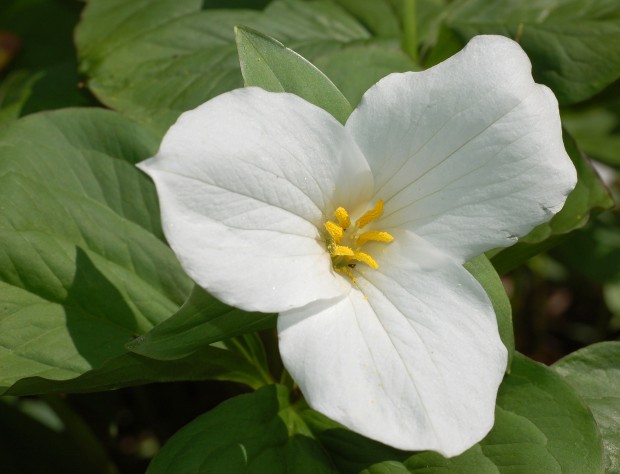 Has the thought of spring crossed my mind yet? Oh yes. The fierce cold, the heavy snow and the ice of the past 3 weeks has made it easy to daydream about spring. Better than 30 years ago I was able one October to buy five acres of rolling land (burdened with an utterly dysfunctional house) blessed with a substantial stand of trillium grandiflorum – the native Michigan trillium. I was not expecting them, but in late April, there they were. I was enchanted. The three lobed flowers are almost as large as the leaves-showy. The trillium blooming provoked an interest in Michigan wildflowers.
Has the thought of spring crossed my mind yet? Oh yes. The fierce cold, the heavy snow and the ice of the past 3 weeks has made it easy to daydream about spring. Better than 30 years ago I was able one October to buy five acres of rolling land (burdened with an utterly dysfunctional house) blessed with a substantial stand of trillium grandiflorum – the native Michigan trillium. I was not expecting them, but in late April, there they were. I was enchanted. The three lobed flowers are almost as large as the leaves-showy. The trillium blooming provoked an interest in Michigan wildflowers.
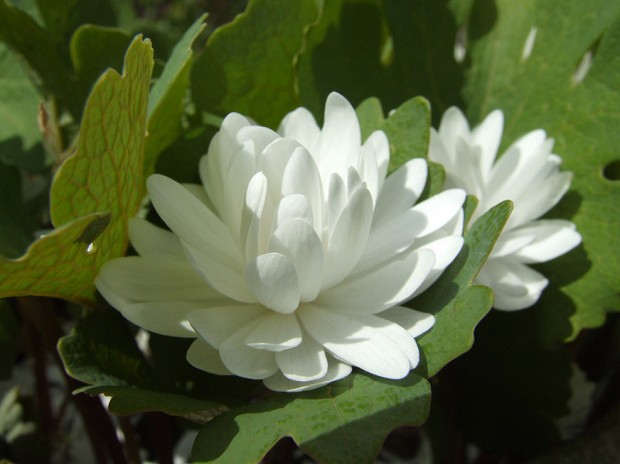 Over a period of years, I added lots of other wild flowers to that spot. I would guess it was 2500 square feet or so, dominated by a few old ash and locust trees. The ground had not be disturbed for many years, or had any of the leaves been removed. But for the tree roots, one could dig in this compost based soil with 2 fingers. The double bloodroot pictures above from Wikimedia never made large colonies, but what I had was persistent. The main trick was to check the plants as often as possible once they come in to bud. Any warm weather or wind, and the petals would drop. Looking every bit like a cross between a miniature peony and a waterlily, they might be in bloom but a few hours a year.
Over a period of years, I added lots of other wild flowers to that spot. I would guess it was 2500 square feet or so, dominated by a few old ash and locust trees. The ground had not be disturbed for many years, or had any of the leaves been removed. But for the tree roots, one could dig in this compost based soil with 2 fingers. The double bloodroot pictures above from Wikimedia never made large colonies, but what I had was persistent. The main trick was to check the plants as often as possible once they come in to bud. Any warm weather or wind, and the petals would drop. Looking every bit like a cross between a miniature peony and a waterlily, they might be in bloom but a few hours a year.
I did spend a few years working for Francis Hughes in the late 70’s and early 80’s. His nursery was unusual, in that he sold native wildflowers dug from his own extensive gardens. One plant which I especially admired was anemone nemerosa. I can still remember him digging me a small start from which he shook off all of the soil. He made a point of telling customers that he did not sell his soil. I was sure my unceremoniously bare rooted plant would not survive, but this plant and many others did indeed grow. The cultivar “Vestal”, pictured above courtesy of www.collectorsnursery.com, is a hybrid noted for its prominent anemone center.
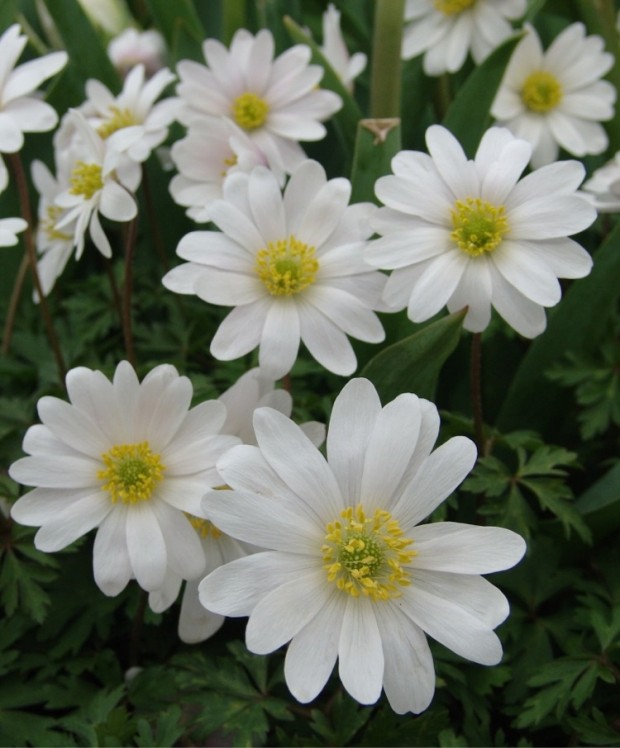
anemone blanda is is not native to Michigan, but its white flowers come early in the spring. The small corms are planted in the fall. I soak the dark brown nuggets for 24 hours before planting them 2-3 inches below ground. The 6 inch tall plants will readily colonize large areas – even weedy or grassy areas – if they are happy. The purple and pink varieties are lovely, but I love the white the best. A few hundred bulbs planted in the untended remains of an orchard multiplied many times over. This picture is from John Sheepers bulbs.
 White epimedium, a perennial groundcover, spreads more slowly and blooms later than other species, but it is well worth the trouble. They are tolerant of dry shade, which makes them an ideal addition to a wild flower garden with mature trees. They bloom on foot tall slender stalks, the new foliage coming after the flowers. This picture- from www.plantsnouveau.com.
White epimedium, a perennial groundcover, spreads more slowly and blooms later than other species, but it is well worth the trouble. They are tolerant of dry shade, which makes them an ideal addition to a wild flower garden with mature trees. They bloom on foot tall slender stalks, the new foliage coming after the flowers. This picture- from www.plantsnouveau.com.
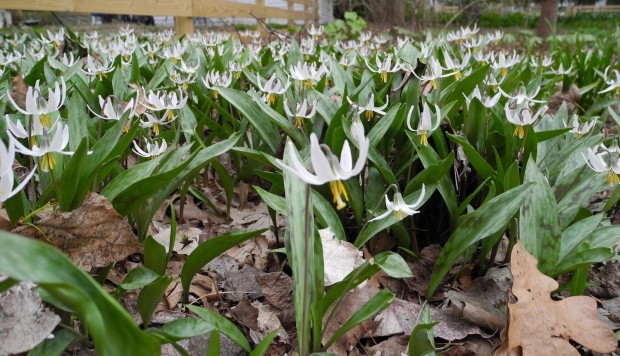 The yellow species trout lily is a familiar face in the Michigan spring wildflower garden, but the white epimedium conalba “Alabaster” is strikingly beautiful. They are fairly easy to grow, but can take years to flower. They are well worth the wait. Like many other wildflowers, the plants go entirely dormant once the trees get their leaves, and the rain is less reliable. Wild flowers are frequently referred to as garden ephemerals, as their dormant season comes early in the summer. The photograph above is from www.phytofactor.fieldofscience.com.
The yellow species trout lily is a familiar face in the Michigan spring wildflower garden, but the white epimedium conalba “Alabaster” is strikingly beautiful. They are fairly easy to grow, but can take years to flower. They are well worth the wait. Like many other wildflowers, the plants go entirely dormant once the trees get their leaves, and the rain is less reliable. Wild flowers are frequently referred to as garden ephemerals, as their dormant season comes early in the summer. The photograph above is from www.phytofactor.fieldofscience.com.
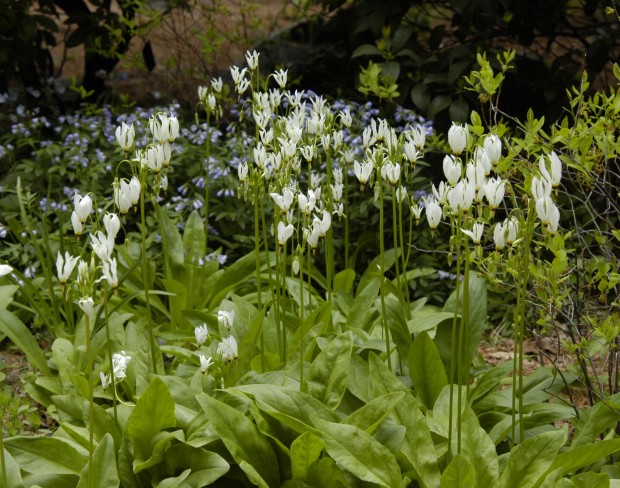 Dodecatheon media is commonly referred to as shooting star. This is a good description for these diminutive flowers with extremely reflexed petals. The foliage is lettuce-lush and juicy looking. They are easy to grow, and will colonize readily when happy. This picture is from www.mtcubacenter.org.
Dodecatheon media is commonly referred to as shooting star. This is a good description for these diminutive flowers with extremely reflexed petals. The foliage is lettuce-lush and juicy looking. They are easy to grow, and will colonize readily when happy. This picture is from www.mtcubacenter.org.
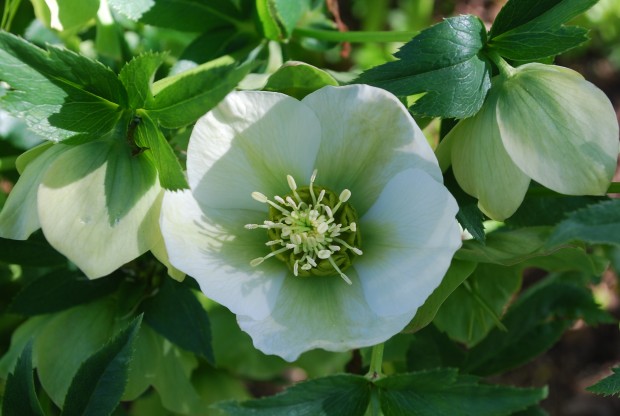 Hellebores are not naive, or are they wild flowers. They are perennials with mostly evergreen foliage. But no discussion of white flowers in early spring would be complete without them. Helleborus orientalis is commonly known as the Lenten rose, as it blooms at that time of year. They are one of my favorite perennials, as they are as beautiful in leaf as they are in flower. There are numerous cultivars, each one more lovely than the last.
Hellebores are not naive, or are they wild flowers. They are perennials with mostly evergreen foliage. But no discussion of white flowers in early spring would be complete without them. Helleborus orientalis is commonly known as the Lenten rose, as it blooms at that time of year. They are one of my favorite perennials, as they are as beautiful in leaf as they are in flower. There are numerous cultivars, each one more lovely than the last.
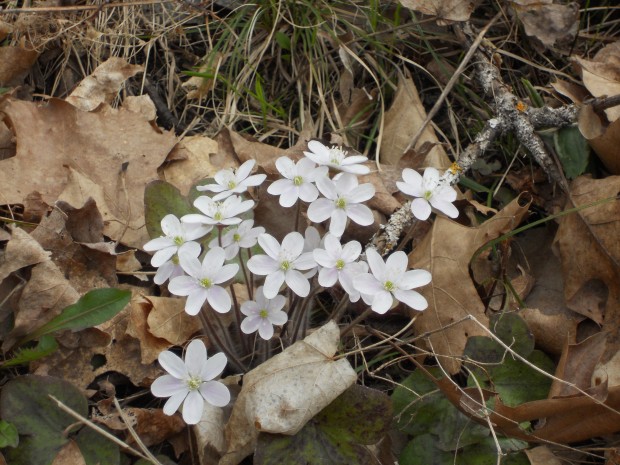 For whatever reason, hepatica was always my favorite spring wildflower. The area where I lived 30 years ago was decidedly rural, but on the cusp of development. Whole neighborhoods full of homes were built nearby, after the land was scraped clean of any and every plant. I dug many a clump of hepatica out of the way of a bulldozer, and relocated them to my property. With a little oak leaf mold, and slightly swampy conditions, they were very happy. I like to believe they are still thriving from benign neglect in those spots, as I know that garden has not been touched by the owner who came after me. This photograph via www.pickerelhills.com.
For whatever reason, hepatica was always my favorite spring wildflower. The area where I lived 30 years ago was decidedly rural, but on the cusp of development. Whole neighborhoods full of homes were built nearby, after the land was scraped clean of any and every plant. I dug many a clump of hepatica out of the way of a bulldozer, and relocated them to my property. With a little oak leaf mold, and slightly swampy conditions, they were very happy. I like to believe they are still thriving from benign neglect in those spots, as I know that garden has not been touched by the owner who came after me. This photograph via www.pickerelhills.com.
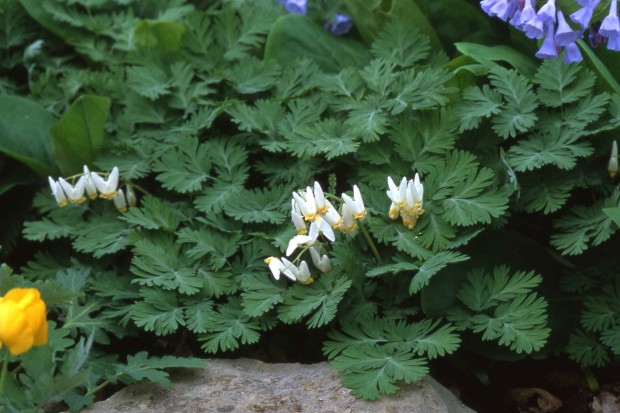 Dutchman’s Breeches are a wilding bleeding heart. The plants feature serrated blue green leaves in profusion. The bleeding hearts are arranged all along a small arching stem. They were very shy bloomers for me. Charming, these.
Dutchman’s Breeches are a wilding bleeding heart. The plants feature serrated blue green leaves in profusion. The bleeding hearts are arranged all along a small arching stem. They were very shy bloomers for me. Charming, these.
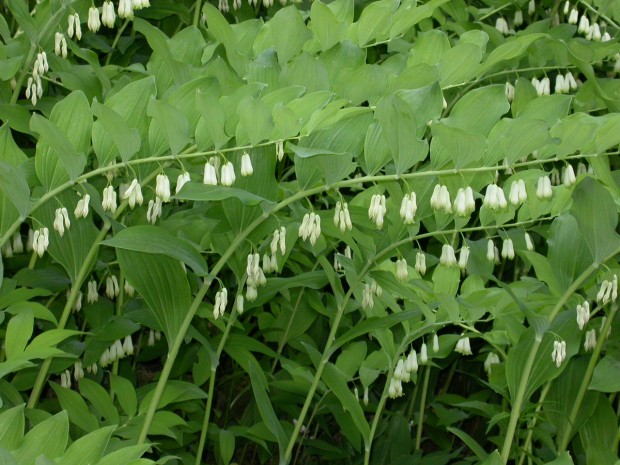 Solomon’s Seal has a similar arrangement of individual blooms. The foliage is also arranged along the stem. The plant is quite tall, and vigorous. Some gardeners prefer the variety sporting white variegated leaves, but I have always liked the more subtle species. I found this great picture at www.solomonsseal.wordpress.com.
Solomon’s Seal has a similar arrangement of individual blooms. The foliage is also arranged along the stem. The plant is quite tall, and vigorous. Some gardeners prefer the variety sporting white variegated leaves, but I have always liked the more subtle species. I found this great picture at www.solomonsseal.wordpress.com.
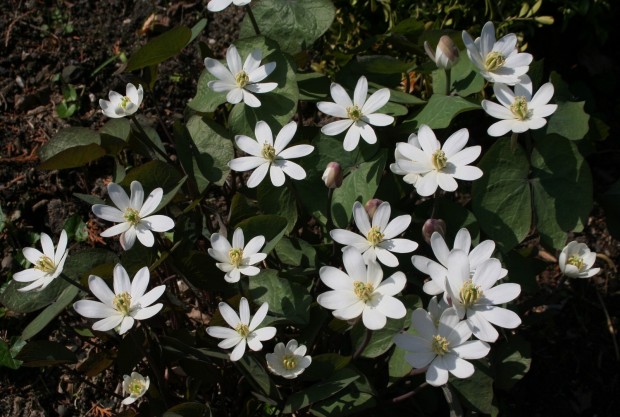 Jeffersonia Diphylla is commonly known as twin leaf. Though this picture does not do justice to the leaf structure, what appears to be 2 leaves at the end of a leaf stalk is actually one leaf, deeply divided. This wildflower was named in honor of Thomas Jefferson by his friend and fellow botanist William Bartram. Only one other species of Jeffersonia is known, and it is native to Japan. Why that would be, I have no idea. This photograph is from www.urvforum.be.
Jeffersonia Diphylla is commonly known as twin leaf. Though this picture does not do justice to the leaf structure, what appears to be 2 leaves at the end of a leaf stalk is actually one leaf, deeply divided. This wildflower was named in honor of Thomas Jefferson by his friend and fellow botanist William Bartram. Only one other species of Jeffersonia is known, and it is native to Japan. Why that would be, I have no idea. This photograph is from www.urvforum.be.
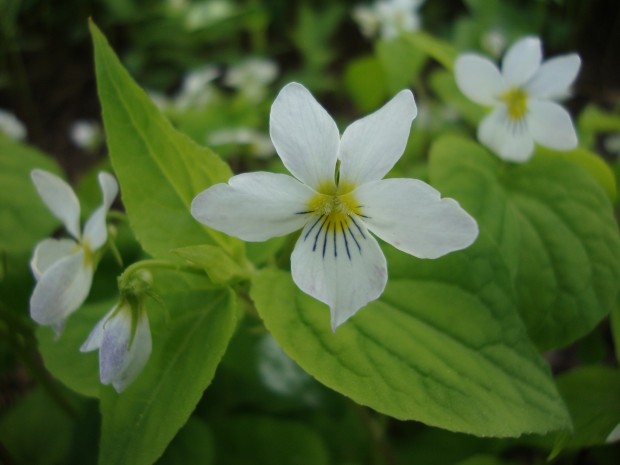 Last but not least, Viola Canadensis, the Canada violet. They are quite rare in some places they are known to be native, but they grew vigorously for me. All of the violets were willing and able to cover the ground. Once the wildflowers went dormant, there were plenty of violets covering the ground. Sweet, that. Very sweet to think that a lot will be happening in the garden in the not so distant future.
Last but not least, Viola Canadensis, the Canada violet. They are quite rare in some places they are known to be native, but they grew vigorously for me. All of the violets were willing and able to cover the ground. Once the wildflowers went dormant, there were plenty of violets covering the ground. Sweet, that. Very sweet to think that a lot will be happening in the garden in the not so distant future.

Fascinating as always…how do you manage to be so productive?
Dear Michaele, I don’t know if I understand your question. If you are referring to the writing, I try to keep up! Deborah
Well, many garden bloggers don’t also run a successful business that demands the physical and creative energy that yours does. And yet ,you make time to come up with posts that showcase wonderful pictures and such interesting accompanying information. I guess i was just expressing admiration. I sure hope I didn’t unintentionally sound sarcastic.
Dear Michaele, it never crossed my mind that you were being sarcastic! In January, I am not working outside, so it’s the perfect time to scale back. There’s more time to write. Come February, I do have a stack of design projects I will need to get to. Best, Deborah
Awesome. Beautiful. My favorite wildflowers looking absolutely gorgeous. You really nailed it, Deborah! Wow. Great photos. Don’t you miss Frances Hughes? He was a wonderful gardener with a fine collection of plants.
Thanks for a breath of spring – the trillium in the first photo was unexpected – a perfect beginning.
Extremely anxious for spring to come. Only a few more months. You give me lots of ideas to contemplate on. Always look forward to reading your blog. Thank you Deborah!
Thank you so much for today’s white native/wild flower information. It brings to mind many days hiking the woods where my father grew up near Mesick, Michigan. As a child I remember huge patches of trillium, dutchman’s breeches and others and the occasional lady slipper. My parents taught us about each plant as we closely examined them each spring. I ate wintergreen berries, and we hunted for morels. I sure wish I could be transported back to those times. I too hope for early spring weather…
Thanks for helping me ignore the snow and think of all those beautiful white flowers of spring. I have a wonderful clump of Trillium grandiflorum that was here when we bought our house. A real treasure.
Dear Linda, even two minutes not thinking about all the snow is worthwhile. Our winter started in mid November-it’s been interminable, and its barely mid January! Deborah
Thank you for posting this! I still remember my fascination with trilliums when I saw these magical plants one early Spring, in the native forest of the New York Botanical Garden. I immediately wanted to acquire a few for my garden in Michigan. Since they are a protected species, it was hard finding a nursery in Michigan that would sell them. Because of that reason it probably was unethical – and possibly illegal – to collect these plants in the woods. One nursery in Michigan would only sell ‘rescued’ trilliums ,,, and those were, thankfully, in short supply. I did manage to find, however, through eBay, a nursery in Tennessee. The trillium bare roots that I acquired from them were planted last Fall, in a bed under Delaware Valley White azaleas. I just can’t wait to see how they will develop there …
Dear Antoine, in my 20’s there were no end of places slated to be bulldozed where I could dig plants. I didn’t worry about illegal-anything I did not dig was gone. And Hughes Gardens-Francis sold wildflowers from his own extensive wild flower garden. Now, you might find a local wild flower plant sale-I know Cranbrook has had one for years. My perennial supplier sells them in pots in the spring. They are pretty rugged plants. Once they settle in, they should grow fine. Best, Deborah
How odd!I have been wanting to plant wild flowers but haven’t because the bags are mixed colors…….now here you are telling me about white and yellow flowers which is the color of my garden!And I have a creek at the bottom of the property so they would be in a clay,wet soil……..do you have a suggestion for me?Can I buy from you and you send to CALIFORNIA in seed form?
Contessa, wild flowers from seed-you would need to research what nursery might offer that. You probably would be much better off with plants. As for which plants would thrive where you are, a local nursery person would be much more help than I.
Thoroughly enjoyed your stoll through a white-flowering spring. The trillium reminds me of the year that my husband and I rescued as many trillium as we could from the forest behind us that was about to be cut down and scraped bare of any living twig. Every spring we enjoy our rescued treasures that are native here in the Pacific NW. I have some of the white Erythronium, too, which I adore.
Of your lovely white display I’ve only had good luck with the Solomon’s Seal which surprised me because they’re planted in dry shade. Sounds like I should give white epimedium a try.
Thanks for the list.
Dear Nella, epimediums do very well in dry shade. There is always a lot of trial and error-getting plants to grow. Deborah
I am fortunate to have all but three varieties that you mentioned…We moved from Chicago 18 years ago…For the first time, I had the opportunity to learn to garden. I quickly joined the Brighton Garden Club…I learned so much from the experienced gardeners…I found I still can’t get enough..I have a great deal of shade and the white is just glowing! I truly love wildflowers, they are a part of every day. for me.. Thank-you for your interesting writing…..Diane
Dear Diane, thanks for your letter. Other white flowering plants for shade that I think are great-there is a white leaved white flowered brunnera. There are pulmonaria with so many white spots on the leaves that the foliage appears white. White houstonia never did so well for me, but they are beautiful. I was remiss in not including leucojum-one of my favorites. I love the wide grassy foliage and the height of the plants. White camassia did well for me, where the ground was on the soggy side. It has been many years since I had a wildflower garden, but I still remember what a pleasure it was. Deborah
What a great collection of the signs of springs, you are making me wish for May even more! Hopefully February will bring a few snowdrops and before you know it the birds will be singing 🙂
Dear Frank, the birds singing again is always my first sign of spring. We have a ways to go yet, but having some time to think about what a new spring might mean is a time to treasure. Thanks, Deborah
for Antoine in Michigan:
The Cranbrook Gardens Auxiliary has a wildflower sale in mid May. Look on line; they have a large selection. All the plants are either rescued from properties slated for development whose owners are vetted by Cranbrook, or from local gardeners and Auxiliary members who grow wildflowers and have plenty to share.
Thanks for the info, Starr. We do have a strong community of gardeners who value wildflowers. Your early spring wildflower garden is a dream come true! Deborah
Deborah,
I am an avid follower and love all your posts.
I was looking for a way to divide Limelight Hydrangeas. I have successfully split an Annabelle and now I am wondering if you can break the root ball of a Limelight Apart to multiply also
Laurie, I have never tried it! Let me know if it works. Thanks, Deborah